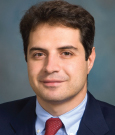Frontline treatment with the antibody-drug conjugate inotuzumab ozogamicin plus deintensified chemotherapy is a promising option for older patients with Philadelphia chromosome–negative acute lymphoblastic leukemia (ALL). Phase II results suggest that this combination has the ability to improve response rates and overall survival in older patients, but further study is needed to confirm these findings.
In this small phase II study, overall response rate was 97%, complete cytogenetic response rate was 100%, and minimal residual disease negativity was 100%.1
“The combination was safe and effective in elderly patients with newly diagnosed ALL. Early results for response rates and ability to achieve minimal residual disease negativity are better than those achieved with a chemotherapy-only approach, and this may become a new standard of care as frontline therapy for elderly ALL patients. Lower doses are being explored,” said lead author Elias Jabbour, MD, of MD Anderson Cancer Center in Houston. He presented these results at the 57th American Society of Hematology Annual Meeting and Exposition.
Inotuzumab ozogomycin is an antibody-drug conjugate that binds to CD22 on the tumor cell surface and releases its payload—a potent chemotherapy (calecheamicin)—into tumor cells. Its mechanism is similar to that of ado-trastuzumab emtansine [Kadcyla] in breast cancer.
Study Details
Older patients with ALL have a poor response to conventional chemotherapy and typically do not receive it. The mini–hyper-CVD regimen employed in this trial is a modification of hyper-CVAD, which is used in younger patients with ALL; the modifications included reduced doses of cyclophosphamide and dexamethasone, no anthracycline, and reduced doses of methotrexate and cytarabine.
Inotuzumab ozogomycin was given on day 3 of the first 4 courses, and mini–hyper-CVD was given for 8 courses. Rituximab (Rituxan) and intrathecal chemotherapy were given for the first four courses. Maintenance therapy with mercaptopurine, vincristine, methotrexate, and prednisone was given for 36 months.
“The combination of inotuzumab ozogamicin, and mini–hyper-CVD has the potential for high efficacy and low toxicity,” Dr. Jabbour said.
The study included 38 patients aged 60 and older with newly diagnosed Philadelphia chromosome–negative ALL. Median age was 69 (the oldest patient was 79). At the time of the 2015 ASH Meeting, 35 patients were evaluable.
Outcomes and Toxicity
Following induction therapy, 34 patients achieved a complete response. The overall response rate was 97%. No deaths were reported during the first 4 weeks of induction therapy. All 19 patients with an abnormal karyotype achieved a cytogenetic complete response; 100% achieved minimal residual disease negativity.
Median time to platelet recovery was 23 days in cycle 1 and 22 days in subsequent cycles. Median time to neutrophil recovery was 16 days and 17 days, respectively.
Notable grade 3 and 4 adverse events included thrombocytopenia (74%), infection during consolidation (74%), infection during induction (53%), and hyperglycemia (50%). Veno-occlusive disease occurred in four patients (10%).
Two-year complete response duration was 81%, and 2-year overall survival was 64%. At a median follow-up of 23 months, 9 patients in complete response died.
Additional Comment
Commenting on this study, Daniel DeAngelo, MD, of Dana-Farber Cancer Institute in Boston, said: “The wave of the future is the combination of monoclonal antibodies plus chemotherapy. We will see extraordinary responses with this approach. Inotuzumab is still an investigational agent, but once approved, I think we will see it combined with chemotherapy in multiple regimens and for different patient populations.” ■
Disclosure: Drs. Jabbour and DeAngelo reported no potential conflicts of interest.
Reference
1. Jabbour E, O’Brien S, Sasaki K, et al: Frontline inotuzumab ozogamicin in combination with low-intensity chemotherapy (mini-hyper-CVD) for older patients with acute lymphoblastic leukemia. 2015 ASH Annual Meeting and Exposition. Abstract 83. Presented December 5, 2015.


